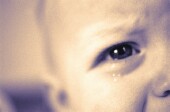
MONDAY, April 30 (HealthDay News) — About one baby an hour is born addicted to powerful painkillers called opiates in the United States, a new study shows.
The number of infants born with a drug withdrawal syndrome called neonatal abstinence syndrome tripled between 2000 and 2009, jumping to more than 13,000, according to a study published online April 30 in the Journal of the American Medical Association.
At the same time, use of prescription painkillers such as oxycodone (OxyContin) by mothers-to-be increased fivefold, the researchers noted.
“This is becoming a big problem and affecting newborns at an alarmingly high and increasing rate,” said study author Dr. Stephen W. Patrick, a fellow in the University of Michigan’s division of neonatal-perinatal medicine in Ann Arbor.
Babies with neonatal abstinence syndrome tend to be irritable, have heightened muscle tone (hypertonia), tremors, feeding intolerance, seizures and breathing difficulty. They also are more likely than others to be born at a low birth weight. Although other drugs can lead to neonatal abstinence syndrome, prescription painkillers are the usual cause, the study said.
The syndrome was most common among babies born in poor areas and covered by Medicaid, the researchers said.
For the study, researchers looked at national hospital discharge data for the years 2000, 2003, 2006 and 2009.
In 2009, they found that 13,539 newborns were born with neonatal abstinence syndrome. The rate had jumped threefold — from 1.20 per 1,000 hospital births in 2000 to 3.39 per 1,000 hospital births.
About 16 percent of pregnant teens and 7 percent of pregnant women aged 18 to 25 use illicit drugs, according to information cited in the report. Whereas opioid use was established in 1.19 of every 1,000 hospital births in 2000, it was implicated in 5.63 of every 1,000 hospital births by 2009, this study found.
The hospital stay for these drug-exposed newborns averaged 16 days, and the cost increased 35 percent — from $39,400 in 2000 to $53,400 in 2009.
The financial piece provides “added incentive to bolster programs at state levels and prevent this before it happens,” Patrick said.
“We also need to think about how we can care for these babies who are going through withdrawal, minimize their symptoms and get them home quicker,” he added.
Journal publication of the study is slated to coincide with its presentation Monday at the Pediatric Academic Societies’ annual meeting in Boston.
Dr. Marie J. Hayes, a professor at the University of Maine in Orono and co-author of an accompanying journal editorial, said the race is on to find ways to treat and care for these infants. “This is not only an epidemic that continues to grow, but the treatment is not well-developed and the babies are suffering a lot,” she said. “There may also be long-term consequences to brain development.”
Opioids are highly addictive, she said. “Once dependent, people are dependent for a long time. It is difficult to treat,” she said. “The mothers are the environment for the baby, so if we want to protect the baby, we have to go through mothers.”
Another expert said the the study speaks to the prevalence of prescription drug abuse and the need for prevention.
Christopher Sturiano, an assistant professor of public health at Weill Cornell Medical College and administrative director of Midtown Center for Treatment and Research in New York City, said he often sees the mothers during their postpartum period. But “we need to identify and try to prevent this before or during pregnancy as opposed to after the fact,” he said.
There are options. “We can tailor opiate replacement therapies to pregnant women to protect the baby,” Sturiano said.
More information
Get the facts on prescription drug abuse from the U.S. Food and Drug Administration.

